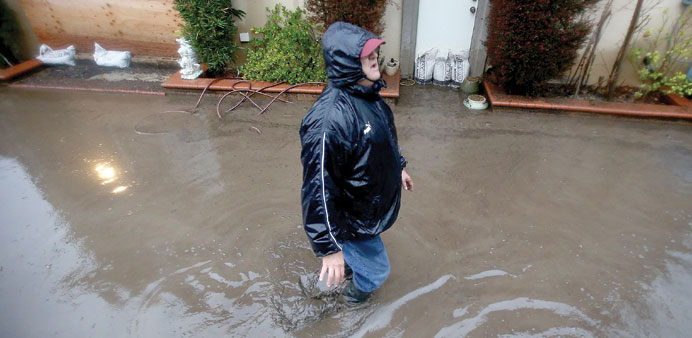By Steff Gaulter
Storms have finally lashed California. The rain is critically needed in the drought stricken state, but not this much rain in such a short period of time. Strong winds brought down trees and caused powercuts to over a thousand homes, and the rain created rockslides and mudslides, which stranded drivers on flooded roads.
Residents along Ridgeview Drive in the Southern California neighbourhood of Azusa were ordered to evacuate their homes, as the risk of mudslides escalated.
Although the weather is causing problems in the short term, in the long term it will be beneficial; California has been in the grip of a drought for the past two years, and it’s been steadily getting worse. A jet stream, a thin ribbon of strong winds high up in the atmosphere, normally guides storms towards the state in winter. These winds are known as the Pineapple Express, as it delivers the rain directly from Hawaii.
However, this winter the jet stream has shifted northwards and the vital winter rains have failed to materialise. The state is now in the grips of the worst drought for a century and more than a dozen communities are believed to be at risk of running out of water within a couple of months.
California is a state which has a history of water problems; the rain is far heavier in the north, but the majority of the population live in the south. In the north, some places receive over 900mm (35 inches) of rain per year, but further south, the rainfall is far less.
Los Angeles, with its population of almost 4mn, has an annual rainfall of 379mm (15 inches), and further inland, Bakerfield has an annual rainfall of less than 144 mm (5.7 inches). For its water supply, much of Southern California relies on a network of reservoirs, aqueducts, power plants and pumping plants, known as the California State Water Project. This moves water from the water-rich north, to the parched south.
The Water Project also provides a means of flood control. Previously each spring, the melting snow in central California’s San Joaquin Valley caused the rivers to swell and overflow. Now that the water is stored and carefully distributed, major cities have boomed along the river banks and the semi-arid desert of the San Joaquin Valley has been transformed into productive farmland.
The California State Water Project supplies water to two-thirds of California’s population. As much as 70% of the water goes to urban users and 30% to agriculture, which is now a huge business in California. According to the US Department of Food and Agriculture, 99% of all almonds and walnuts grown in the US are produced in the state, as are 92% of strawberries and 90% of tomatoes.
To the dismay of the farming community, in February the US Bureau of Reclamation officials announced that the lack of rain meant that it will not be providing Central Valley farmers with any water from the California State Water Project. This was widely expected, but was still extremely disappointing for the farmers. Some took drastic measures, such as pulling out rows of almond trees, saying the cost of maintaining the trees was too much to justify.
The drought has now continued for such an extended period that the soil is dry, as is the vegetation. Wildfires are common place in a Californian summer, but this year, the drought has ensured that wildfires have even been raging in the winter. According to the state Forestry and Fire Protection Department, known as CalFire, up until February 10 this year, 487 wildfires had already ignited compared with only two for the same period a year ago.
The blazes this year follow on from the active fire season of 2013. CalFire responded to 2,000 more fires in 2013 than in an average year, including the enormous Rim Fire. This was one of the largest wildfires on record in California. A state of emergency was declared in San Francisco when the Rim Fire threatened the power and water supplies to the city.
The fires left large burn scars on the landscape, which can be hazardous during heavy rainfall. When the vegetation has been burnt, more soil is exposed to the elements and less plant debris will slow down water as it runs down the hillsides.
This will result in a greater risk of mudslides and flash flooding. In the recent rains, a 10 mile stretch of the Pacific Coast Highway was closed, such was the danger of rockslides.
Downtown Los Angeles reported 110mm (4.3 inches) of rain between February 26 and March 1. This significant amount of rain will certainly help the current situation, but much more is needed in order to end the drought. It was estimated that the state needed 300mm (12 inches) of rain to end it. This latest storm didn’t deliver the rain uniformly, but even Los Angeles needs another 190 mm (7.5 inches) before the drought can be officially classed as over. Unfortunately it looks as if the rain will not return just yet, but even if it did, no one would be wishing for 190mm of rain to fall in one go.



